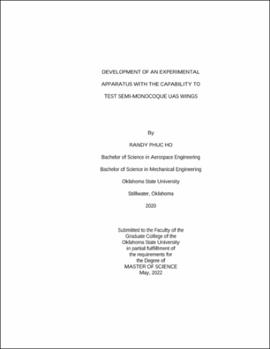| dc.contributor.advisor | Arena, Andy | |
| dc.contributor.author | Ho, Randy Phuc | |
| dc.date.accessioned | 2023-04-03T20:51:25Z | |
| dc.date.available | 2023-04-03T20:51:25Z | |
| dc.date.issued | 2022-05 | |
| dc.identifier.uri | https://hdl.handle.net/11244/337205 | |
| dc.description.abstract | In many aircraft, manned or unmanned, proof loading and failure tests for the wing structure are required to understand the structural characteristics. These are carried out for required certifications and to check if the aircraft can handle the expected flight loads. Theoretical analysis is not generally sufficient enough in certifying aircraft; therefore, physical tests must be conducted. This research is planned to develop a static testing apparatus capable of testing Group I and Group II unmanned aerial vehicle (UAV) wings up to at least 5 G’s and modular for all wing planforms. This apparatus is designed to handle the semi-monocoque composite wings and will use a small-scale whiffletree for simulating the spanwise-lift distribution over the wing. The whiffletree is highly regarded in industry for its ability to best match the shear and bending moment created by lift. Three experiments are conducted after the design and fabrication of the apparatus are completed. Two of these experiments are carried out with the use of an aluminum beam to validate the apparatus’s loading characteristics in a repeatable proof loading case and failure case. Along with the theoretical calculations for these two experiments, an overall complete uncertainty analysis was conducted for the entire apparatus. The final experiment conducted is the test of a fiberglass composite wing designed and fabricated at Oklahoma State University. The results of these experiments yield that the apparatus does transfer loads up to an accuracy of ±5% of the theoretical analyses and that the apparatus can be applied to a composite semi-monocoque wing as intended. Some of the interesting discoveries found in this research were the uncertainty found in the whiffletree design and the failure mode of the wing spar. Due to the construction and requirement to be modular, the whiffletree was found to have a 3% uncertainty in transferring loads. While favorable for its intended purpose at Oklahoma State University, it may require more research to be conducted for more precision in transferring loads for other research. Finally, the failure mode of the wing used in experiment three was found to be a shear failure; however, due to debonding of epoxy on the shear web and skin, it is not possible to decisively say whether the wing failure in normal shear or transverse shear. This experiment also sparks future work and research to be done in studying shear failure in these composite wings. | |
| dc.format | application/pdf | |
| dc.language | en_US | |
| dc.rights | Copyright is held by the author who has granted the Oklahoma State University Library the non-exclusive right to share this material in its institutional repository. Contact Digital Library Services at lib-dls@okstate.edu or 405-744-9161 for the permission policy on the use, reproduction or distribution of this material. | |
| dc.title | Development of an experimental apparatus with the capability to test semi-monocoque UAS wings | |
| dc.contributor.committeeMember | Taylor, Robert | |
| dc.contributor.committeeMember | Paul, Ryan | |
| osu.filename | Ho_okstate_0664M_17651.pdf | |
| osu.accesstype | Open Access | |
| dc.type.genre | Thesis | |
| dc.type.material | Text | |
| dc.subject.keywords | composite UAS wings | |
| dc.subject.keywords | static wing testing | |
| dc.subject.keywords | whiffletree | |
| thesis.degree.discipline | Mechanical and Aerospace Engineering | |
| thesis.degree.grantor | Oklahoma State University | |
